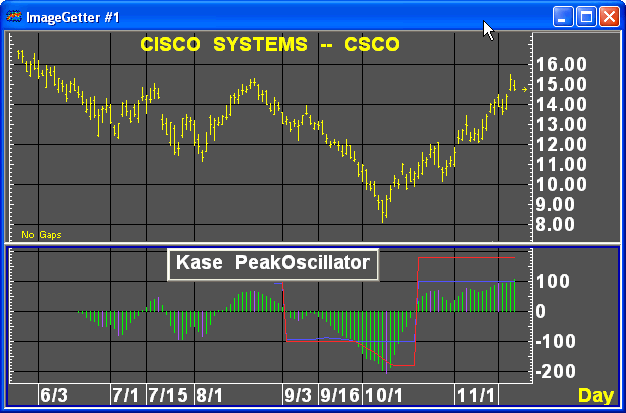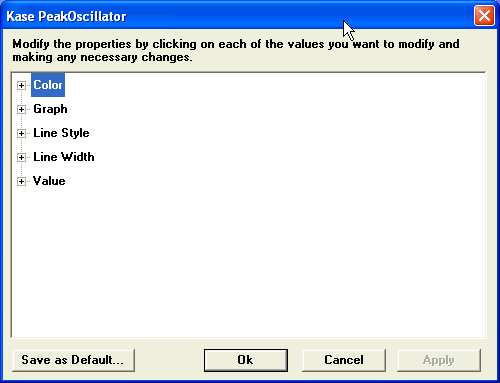
The PeakOscillator is unique among first derivative or "rate-of-change" indicators in that it statistically evaluates over fifty trend lengths and automatically adapts to both cycle length and volatility. In addition, it replaces the crude linear mathematics of old with logarithmic and exponential models that better reflect the true nature of the market.
Thus, the PeakOscillator is a self-optimizing indicator which need not be back tested for optimal inputs as these are self-generated. The PeakOscillator is unique in that it can be applied across multiple time frames and different commodities.
As a hybrid indicator, the PeakOscillator also generates a trend signal via the crossing of the histogram through the zero line. In addition, the purple KPeak histogram line indicates when the oscillator has reached an extreme condition. When the oscillator reaches this peak and then turns, it means that most of the time the market will turn either at the present extreme, or (more likely) at the following extreme.
The study consists of three indicators:
The PeakOscillator itself is rendered as a histogram.
KPeak is a purple line within the histogram signifying a market extreme.
The Blue Kpeak-Min line is a maximum of two standard deviations of the PeakOscillator value.
The Red PeakOut line is a minimum of two standard deviations of the PeakOscillator value.

Interpretation
The PeakOscillator is used two ways:
Divergence: The PeakOscillator
may be used to generate traditional divergence signals. The difference
between it and traditional divergence indicators lies in its accuracy.
PeakOut: The second use is to look for a PeakOut. A PeakOut occurs when the histogram breaks beyond the PeakOut line and then pulls back. A PeakOut through the maximum line will be displayed magenta. A PeakOut, which only extends through the PeakMin line is called a local PeakOut, and is less significant than a normal PeakOut signal.
These local PeakOuts are to be relied upon more heavily during sideways or corrective markets.
PeakOuts may be based on either the maximum line or the minimum line. Maximum PeakOuts, however, are rarer and thus more significant than minimum PeakOuts. The magnitude of the price move may be greater following the maximum PeakOut, but the likelihood of the break in trend is essentially the same. Thus, our research indicates that we should react equally to a PeakOut in a trendy market and a PeakMin in a choppy or corrective market.
The Kase PeakOscillator Study for Aspen Graphics utilizes proprietary formulas to establish market indicators. Certain formula variables may be altered to customize the resultant study indications.

|
Field |
Function |
|
Color |
Indicates the color in which the respective study element is rendered.
Defaults: Peak Osc – Green Kpeak – Purple Peak Min – Blue Peak Max – Red
|
|
Graph |
Indicates the rendering method for the respective study element.
Defaults: Peak Osc – Histogram Kpeak – Histogram Peak Min – Line Peak Max – Line
|
|
Line Style |
|
|
Line Width |
|
|
Value |
Indicates the value of each respective study variable.
Defaults: # of StDevs – 2.0 Cycle Range Low – 8.0 Cycle Range High – 65.0 Scaling Factor – 50.0
|